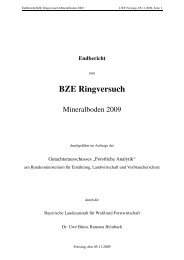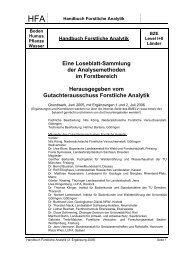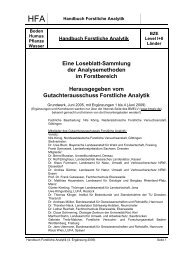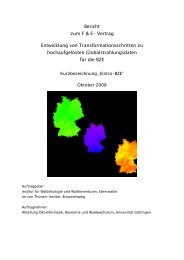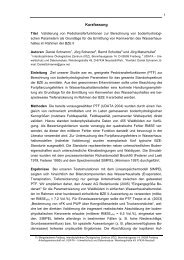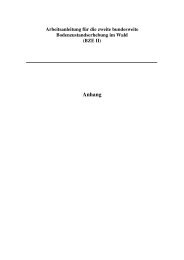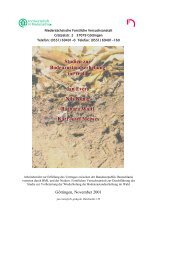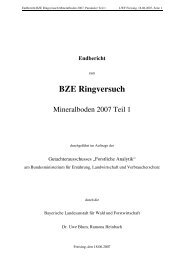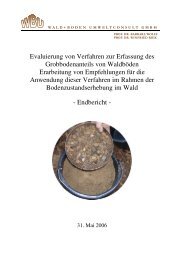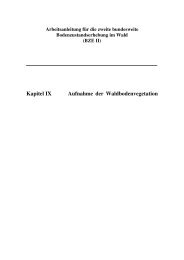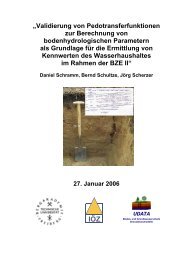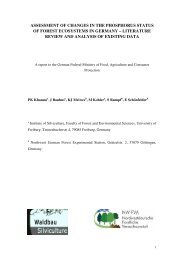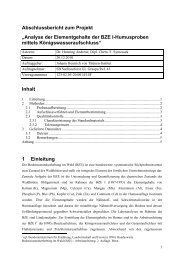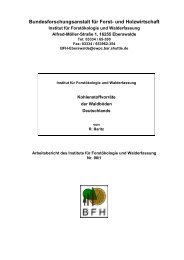assessment of changes in the phosphorus status of forest ...
assessment of changes in the phosphorus status of forest ...
assessment of changes in the phosphorus status of forest ...
You also want an ePaper? Increase the reach of your titles
YUMPU automatically turns print PDFs into web optimized ePapers that Google loves.
that <strong>the</strong>se values should be validated for different soil types, but as a first<br />
approximation a value <strong>of</strong> –25 can be used.<br />
• By us<strong>in</strong>g <strong>the</strong> above values, Ulrich (1972) calculated <strong>the</strong> amount <strong>of</strong> mobilisable or<br />
labile fractions <strong>of</strong> P for two types <strong>of</strong> sites: (a) for diluvial sands with medium<br />
amounts <strong>of</strong> silicate content <strong>the</strong>re may be 530 kg P /ha mobilisable P <strong>in</strong> 0-50cm<br />
depth and (b) for an acid brown earth developed from loess mobilisable P content<br />
<strong>in</strong> 0-25 cm depth may be about 1550 kg/ha.<br />
• These values <strong>of</strong> mobilisable P are much higher than <strong>the</strong> small <strong>changes</strong> which are<br />
expected to occur <strong>in</strong> <strong>the</strong> short period <strong>of</strong> 10 or 20 years <strong>of</strong> tree growth or even<br />
dur<strong>in</strong>g a period <strong>of</strong> one rotation. However P fractions may provide useful<br />
<strong>in</strong>formation on substantial losses associated with erosion <strong>of</strong> surface soils or longterm<br />
litter-rak<strong>in</strong>g activity where a significant proportion <strong>of</strong> organic or mobilisable<br />
P is miss<strong>in</strong>g (Ulrich and Khanna 1969).<br />
It is evident from <strong>the</strong> above discussion that it is possible to develop pedo-transfer<br />
functions, but <strong>the</strong>y cannot be developed based on <strong>the</strong> above given relationships for a<br />
small number <strong>of</strong> sites. Depth-wise distribution <strong>of</strong> different P forms from a wide range<br />
<strong>of</strong> soils will be required to test and develop such relationships fur<strong>the</strong>r. In <strong>the</strong> context<br />
<strong>of</strong> BZE analysis this does not seem to be a practical way to follow.<br />
3.4 Suggested method to assess <strong>changes</strong> <strong>in</strong> P <strong>status</strong> <strong>of</strong> soils<br />
There are a number <strong>of</strong> issues and requirements, which need careful consideration<br />
before an appropriate method can be suggested for future use to assess <strong>changes</strong> <strong>in</strong> soil<br />
P reflect<strong>in</strong>g <strong>the</strong> P <strong>status</strong> <strong>of</strong> <strong>forest</strong> ecosystems. In our view <strong>the</strong> most important issues<br />
are:<br />
1. Short- versus medium- to long-term availability <strong>of</strong> soil P. It is important to<br />
understand that contrary to <strong>the</strong> agricultural systems, where only short term<br />
availability <strong>of</strong> P is <strong>of</strong> <strong>in</strong>terest, <strong>forest</strong> ecosystems require both short- term and longterm<br />
<strong>assessment</strong> <strong>of</strong> availability and <strong>the</strong> amount <strong>of</strong> P available. To determ<strong>in</strong>e shortterm<br />
<strong>changes</strong> it is possible to adapt some <strong>of</strong> <strong>the</strong> methods developed <strong>in</strong> agriculture.<br />
But for medium- to long-term <strong>changes</strong> <strong>forest</strong>-specific methods will be required.<br />
2. The <strong>assessment</strong> <strong>of</strong> P availability will not always provide <strong>the</strong> amount that may be<br />
taken up by <strong>the</strong> trees as <strong>the</strong>re are site and plant specific factors which determ<strong>in</strong>e<br />
68



